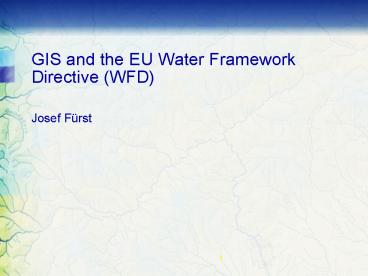GIS and the EU Water Framework Directive WFD PowerPoint PPT Presentation
1 / 25
Title: GIS and the EU Water Framework Directive WFD
1
GIS and the EU Water Framework Directive (WFD)
- Josef Fürst
2
Learning objectives
- In this section you will learn
- Principles of the WFD,
- GIS based reporting duties of the member states,
- Common Implementation Strategy (CIS) of GIS
elements
3
Outline
- Introduction to the WFGD
- Reporting duties of member states
- Austrian procedure
- Summary report 2004
- CIS Guidance document GIS
- European GIS feature coding
- Summary
4
Introduction to the WFD
- The WFD
- establishes a framework for the protection of all
waters - rivers, lakes, coastal waters, and
groundwaters. - sets up a system of management within river
basins that recognises that water systems do not
stop at political borders - requires cross border co-operation between
countries and all involved parties - ensures active participation of all stakeholders
in water management activities - ensures reduction and control of pollution from
all sources like agriculture, industrial
activity, and urban areas, etc. - requires water pricing policies and ensures that
the polluter pays - balances the interests of the environment with
those who depend on it - Overall, the Directive aims at achieving good
water status for all waters by 2015.
5
Reporting by member states
- Analysis of current status and regular updates
6
Berichtspflichten der Mitgliedsstaaten
- Betrifft nicht nur WRRL, auch andere RL
7
Reporting by member states / Schedule
8
Reporting by member states / Schedule
9
Austrian procedure
- New water law 2003 ? a.o. WISA
10
Austrian procedure
- Format of reports according to WFD and EC (Marent
2003)
11
Maps reporting current state 2004 (Ö)
- Overview maps DIN A3
- National share of river basins Danube, Rhine,
Elbe - Density of population and tourism 2001
12
List of maps in analysis of current state 2004 (A)
- Surface waters M 1500.000
- O 1 Gewässertypologie von Oberflächengewässern
- O 2 Oberflächenwasserkörper gemäß Basiseinteilung
(einschließlich Wasserführungen) - O 3 Belastungen von Oberflächengewässern
punktuelle Belastungen - O 4 Belastungen von Oberflächengewässern
diffuse Belastungen - O 5 Belastungen von Oberflächengewässern
Eingriffe in die Gewässerhydrologie
(Wasserentnahmen, Schwellbetrieb und
Stauhaltungen) - O 6 Belastungen von Oberflächengewässern nicht
fischpassierbare Querbauwerke - O 7 Belastungen von Oberflächengewässern
Eingriffe in die Gewässermorphologie - O 8 Immissionssituation und biologisches
Gewässergüte der Oberflächengewässer - O 9 Risikoanalyse der Oberflächenwasserkörper in
Hinblick auf eine mögliche Zielverfehlung
stoffliche Belastungen - O 10 Risikoanalyse der Oberflächenwasserkörper in
Hinblick auf eine mögliche Zielverfehlung
allgemeine physikalisch chemische Parameter und
biologische Gewässergüte - O 11 Risikoanalyse der Oberflächenwasserkörper in
Hinblick auf eine mögliche Zielverfehlung
chemische Schadstoffe - O 12 Risikoanalyse der Oberflächenwasserkörper in
Hinblick auf eine mögliche Zielverfehlung
Gesamtergebnis - O 13 Vorläufige Ermittlung der künstlichen und
erheblich veränderten Oberflächenwasserkörper
(Kandidatenausweisung)
13
Karten IST-Bestandsanalyse 2004 (Ö)
- Grundwasser M 1500.000
- G 1 Lage und Grenzen der Grundwasserkörper (inkl.
Messnetz für die Erhebung der Wasserqualität) - G 2 Lage und Grenzen der Grundwasserkörper (inkl.
Messnetz für die Erhebung des Wasserkreislaufs) - G 3 Allgemeine Charakteristik der über dem
Grundwasser liegenden Schichten im Einzugsgebiet
der Grundwasserkörper - G 4 Belastungen von Grundwasserkörpern -
stoffliche Belastungen (Landnutzung und
Viehdichte) und künstliche Anreicherungen - G 5 Ergebnisse der Risikobeurteilung für den
chemischen Zustand von Grundwasserkörpern - G 6 Ergebnisse der Risikobeurteilung für den
mengenmäßigen Zustand von Grundwasserkörpern - Schutzgebiete M 1500.000
- S 1 Schutzgebiete gemäß Artikel 7 der WRRL
Entnahme von Wasser für den menschlichen Gebrauch
- S 2 Sonstige Schutzgebiete gemäß Anhang IV der
WRRL
14
Maps in analysis of current state 2004
- Examples
15
Karten IST-Bestandsanalyse 2004 (Ö)
16
(No Transcript)
17
(No Transcript)
18
(No Transcript)
19
CIS Guidance document GIS
- To unify the procedures Common Implementation
Strategy Guidance documents - Guidance document no. 9 Implementing the GIS
Elements of the WFD166 S., accessible at
http//europa.eu.int/comm/environment/water/water-
framework/guidance_documents.html
20
CIS guidance Implementing the GIS elements of
the WFD
- The common understanding on terms and on the role
of GIS in the WFD - The maps and GIS layers requested for reporting
under the WFD - How to validate the GIS layers
- How to document the GIS layers
- How to report GIS layers to the European
Commission - How to harmonise data at borders and how to
co-ordinate the reporting process - How to introduce a European feature coding system
21
CIS Guidance document GIS - contents
- Detailed data models
- Guidelines for accuracy and resolution
- Acquisition 1250000, presentation 11 Mio, in
future 1250000
22
CIS Guidance document GIS - contents
- European coding of GIS objects
- Validation / meta data / exchange formats
- Harmonisation, coordination, organisation
23
European coding of GIS objects
- Uniqueness within MS and EU now
- EU, state, RBD-authorities, elements of drainage
network
24
European coding of GIS objects
- Structured coding including information on
topology of river network ? modified Pfafstetter
system (medium term)
25
Summary
- WFD explicitly refers to GIS based reporting
- Implementation is specified in detail by CIS
- Austria established WISA in water law 2003
- Pragmatic approach to analysis of current state
2004 - Distributed data management and unified object
oriented data model is the goal - Structured coding (Pfafstetter) shall simplify
analyses and presentation

